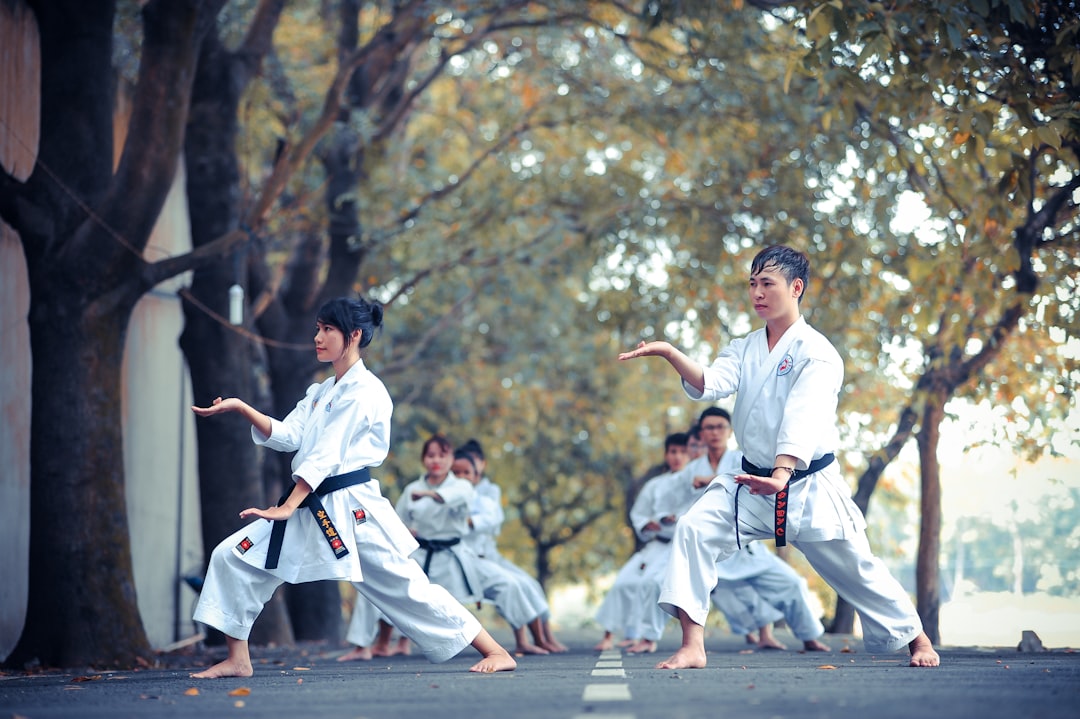Martial arts uniforms, commonly referred to as Gis, are essential for practice, offering a blend of cultural significance and practical functionality. Originating from the traditional attire used by Okinawan practitioners, the modern Gi has evolved to include durable and lightweight fabrics like cotton or polyester that facilitate unrestricted movements necessary for executing martial arts techniques. These uniforms also serve as a visual indicator of rank, with different colors and designs reflecting the wearer's skill level and commitment to karate. While maintaining their traditional aesthetic, modern Gi have incorporated advancements such as moisture-wicking properties and reinforced areas for added protection during sparring. This balance between honoring martial arts' rich heritage and embracing modern design enhances both the performance and comfort of today's practitioners, making martial arts uniforms a central aspect of the discipline's tradition and training.
delve into the rich tapestry of martial arts culture, an essential aspect is the attire that practitioners don, embodying both tradition and functionality. This article explores the significance of martial arts uniforms, with a focus on the karate gi. From its origins to modern variations, we’ll unravel the key features that define this garb and reveal how it has adapted over time to meet the needs of contemporary practice while maintaining its symbolic importance. Join us as we examine the evolution of the karate outfit within the broader context of martial arts uniforms.
- Understanding the Significance of Martial Arts Uniforms: A Glimpse into Tradition and Functionality
- The Evolution of Karate Gi: Evolving Style and Symbolism
- Key Features of a Traditional Karate Outfit: Fabric, Fit, and Function
- Modern Variations in Karate Uniforms: Adaptation and Innovation in Martial Arts Attire
Understanding the Significance of Martial Arts Uniforms: A Glimpse into Tradition and Functionality

Martial arts uniforms serve as a symbolic representation of the discipline and respect inherent to the martial arts tradition. These garments, often referred to in the context of karate as “Gis,” are more than mere attire; they are an embodiment of the practitioner’s commitment to the art. Constructed from cotton or lightweight materials, these uniforms allow for ease of movement and comfort during training, facilitating the full range of motion necessary for executing techniques effectively. They also serve a practical purpose, as the loose-fitting design enables students and instructors to observe each other’s movements and correct form without restrictive clothing.
In addition to their functional aspects, martial arts uniforms also hold significant cultural importance. Each component of the Gi has its own meaning, often symbolizing rank or level within a particular discipline. For instance, the color of the belt indicates the wearer’s experience and proficiency in karate. The traditional white Gi represents purity and humility, reinforcing the idea that no matter one’s skill level, all practitioners start with the same foundation. As students progress through their training, they not only gain physical strength and agility but also an understanding of the deep-rooted traditions and philosophies that underpin martial arts practice.
The Evolution of Karate Gi: Evolving Style and Symbolism

Throughout the history of karate, the evolution of martial arts uniforms, commonly known as ‘Gis’, has been both practical and symbolic. Initially, practitioners trained in loincloths or simple cotton garments suitable for the tropical climate of Okinawa, where karate originated. Over time, the need for a more standardized training attire led to the development of the Gi as we know it today. These uniforms are constructed from heavy cotton or hemp fabric, featuring a jacket and trousers, which facilitate movement and allow for ease of motion during practice and competition.
The traditional Gis originally bore no specific emblems or patterns; their primary function was to provide a consistent garment that could withstand the rigors of martial arts training. However, as karate’s popularity grew globally, so did the symbolism associated with the Gi. Today, the color and style of a Gi can signify rank, affiliation, and even the discipline of karate being practiced. For instance, does the color of the belt attached to the GI indicate the wearer’s level of skill? Absolutely. White Gis are commonly used in the early stages of training, while higher-ranking practitioners often wear darker-colored Gis as a symbol of their advanced expertise and discipline within the martial art. The evolution of martial arts uniforms has thus not only been about functionality but also about the expression of tradition, status, and the shared spirit of karate.
Key Features of a Traditional Karate Outfit: Fabric, Fit, and Function

When practicing karate, the attire one wears is not merely a uniform but a symbol of respect for the tradition and discipline that karate embodies. A traditional karate outfit, often referred to as martial arts uniforms, typically consists of a jacket and pants. The fabric used in these martial arts uniforms is usually lightweight and breathable, allowing practitioners to move freely without constraint. Is the fabric of a karate uniform significant? Absolutely, as it must be durable enough to withstand the rigors of training while still offering comfort for a wide range of movements. The fit of a karate outfit is tailored to facilitate both the execution of karate techniques and to signify the wearer’s commitment to the martial art. Are the fit and cut of these uniforms designed with purpose? Indeed, they are crafted to accommodate the specific needs of karate practice, ensuring that the garment does not hinder or distract from the techniques being performed.
The function of a traditional karate outfit extends beyond mere attire; it serves as a canvas for practitioners to express their dedication and respect for the art. The uniform’s design, which often includes a belt system indicating rank, reinforces the structured nature of the martial art. Does the function of these uniforms align with the principles of karate? Yes, they are designed to complement the discipline and focus required during practice and competition, providing an environment where the practitioner can fully immerse themselves in the martial art without external distractions. In essence, the traditional karate outfit, or martial arts uniforms, is a testament to the unity of form and function, honoring the rich history of karate while supporting its modern practice.
Modern Variations in Karate Uniforms: Adaptation and Innovation in Martial Arts Attire

Martial arts uniforms have undergone significant evolution over time, reflecting both functional and aesthetic adaptations to suit modern training needs and cultural preferences. Traditional karate gis, which are white cotton garments, have been the standard for decades, offering durability and comfort during practice and competition. However, with advancements in fabric technology and changing martial arts landscapes, new variations have emerged, each serving a specific purpose or catering to different training conditions.
Are today’s karate uniforms vastly different from their traditional counterparts? The answer is multifaceted. While the foundational concept remains the same—a top and bottom garment that allows for ease of movement—modern iterations incorporate diverse materials such as polyester, which provides better moisture-wicking properties, or reinforced areas for added protection during sparring. Additionally, these contemporary uniforms may feature design elements like pre-shaped cuffs or stretch panels to enhance the wearer’s range of motion and comfort. These adaptations ensure that martial arts uniforms not only maintain their traditional essence but also meet the demands of modern training, providing practitioners with the best of both worlds.
Martial arts uniforms serve as more than mere garments; they encapsulate the traditions, functions, and evolution of the discipline they represent. In examining the karate gi specifically, one can appreciate the transformation from practical attire to a symbol of respect and adherence to the martial art’s roots. From the key features that define a traditional karate outfit to the modern variations that cater to contemporary needs without compromising integrity, it is evident that these uniforms play a pivotal role in the practice and preservation of martial arts culture. As martial artists around the world continue to honor and adapt these traditions, the significance of martial arts uniforms, including karate gis, remains an integral aspect of the training and competitive arenas.
